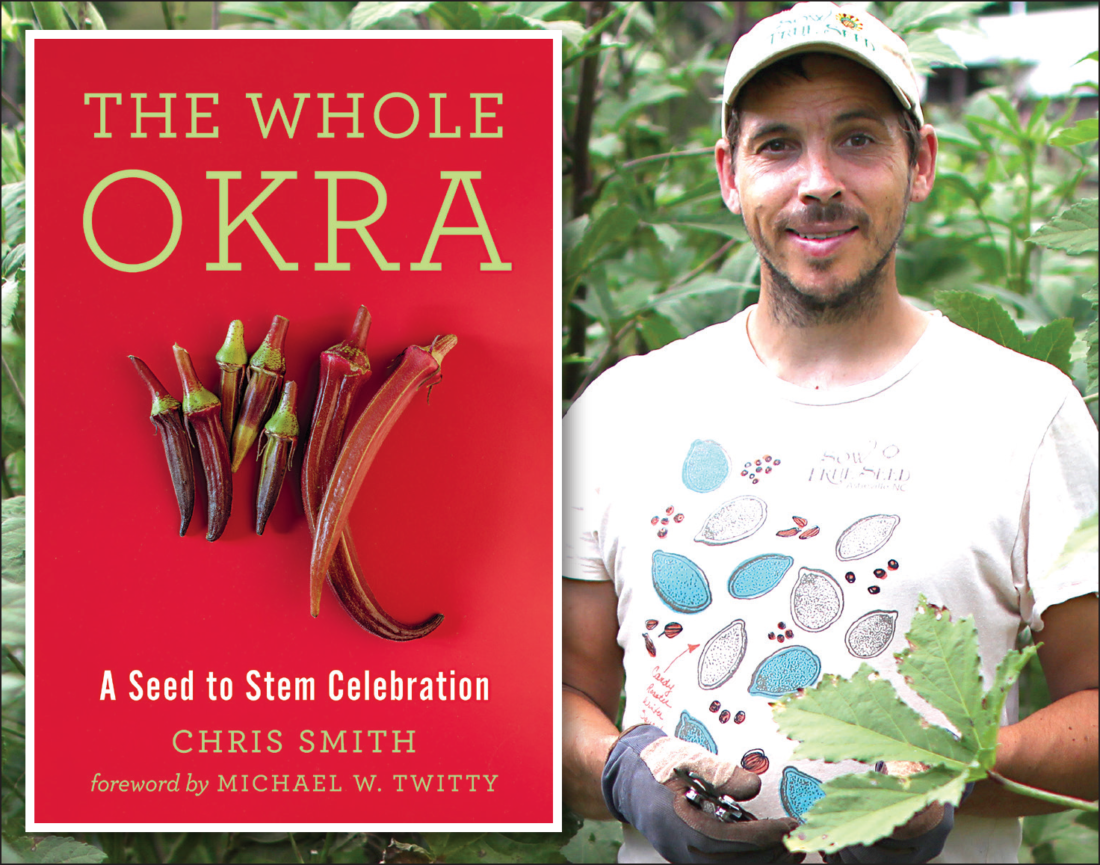People tend to divide into two distinct camps over the subject of okra: the starry-eyed lovers and the avowed haters. So widespread is okra’s notoriety for, well, let’s just say abundant viscosity, that some haters set their minds without even giving the vegetable a taste.
But among the ranks of its supporters in Asheville, there is at least one person who could be considered a bona fide okra crusader. In his new book, The Whole Okra: A Seed to Stem Celebration, Sow True Seed’s marketing and communications manager, Chris Smith, makes a compelling case that the humble abelmoschus esculentus — a member of the mallow family and relative of cocoa, hibiscus and cotton — gets a bad rap.
“Not embracing okra because it’s slimy is like not visiting the Alps because you’re scared of heights,” Smith admonishes in the book’s introduction. “You’re missing out on so much because of one small, manageable aversion.”
In addition to the surprising range of recipes (some are even slime-free) he highlights in The Whole Okra for the familiar okra pods, Smith spent years researching and developing an astonishing number of culinary applications for the seeds, leaves and beautiful flowers of the easy-to-grow and highly productive plant.
He found that the seeds can be made into nutritious flour, tofu, tempeh, oil — and he even experimented (not entirely to his satisfaction) with using them as a coffee substitute. The flowers are good for snacking on right out of the garden, he points out, but can also be fried, infused into alcohol, extracted into vinegar and made into tea. And although they’re spiny and mucilaginous, the large, protein-rich leaves are excellent fried and cooked in stews and soups, and the tiny leaves of seedlings can be eaten like microgreens.
Despite his passion, Smith is the first to admit that he’s an unlikely champion for okra. A native of Great Britain — a land where okra is rarer than hot, sunny days — his first encounter with the vegetable was in an unappetizing fried form at a diner in Georgia in 2006. Because of his personal lack of okra roots, he called on a range of chefs and food experts from Asheville and beyond in creating his book.
“I don’t have this deep cultural heritage around okra, so it was important to me that I capture those voices,” says Smith. African American food historian and James Beard Award-winning author Michael Twitty wrote the foreword and contributes a 19th-century-inspired recipe for okra soup. “A Chef’s Life” star Vivian Howard weighs in on the best methods for frying okra. The Wild Wisdom of Weeds author Katrina Blair traipses into blow-your-mind territory, capitalizing on the slime with a recipe for okra marshmallow delights — Smith swears the “perfectly sweet, deep green chewy treats” are addictively delicious.
Closer to home, Chai Pani owner Meherwan Irani discusses the salt-and-lime preparation method for his restaurant’s wildly popular (and nonslimy) okra fries and supplies a recipe for bhindi masala. Asheville Tea Co. owner Jessie Dean experiments with okra flower teas. Chad Oliphant of Smiling Hara plays around with okra seed tempeh, and Sarah Wickers of Well Seasoned Table produces a roasted okra seed sea salt seasoning. At OWL Bakery, Maia Surdam discovers that okra-seed flour makes wonderful muffins and sourdough bread.
Although many of the food uses highlighted in the book are far from mainstream, the one recipe that caught Smith off guard was AUX Bar chef Steven Goff’s okra kimchi. “It’s the one recipe that really makes my mouth water just thinking about it,” he says. “It’s tangy, spicy and still got that okra crunch. Everything is there.”
True to its name, in The Whole Okra Smith pushes beyond the plant’s edibility to explore practical — and sometimes whimsical — uses for its fibers (paper and cordage), dried pods (holiday ornaments, decorative lights, mushroom-growing medium) and, yes, even the slime (facial mask, hair conditioner). He even encountered a Mayan variety with hollow petioles (stems) that, when dehydrated, form perfect drinking straws.
In the end, the overarching theme of the book is sustainability and how focusing on seed-to-stem crops can strengthen our food system in the face of climate change. In 2018, through his work with the Utopian Seed Project (a nonprofit committed to developing diverse food systems in the Southeast), Smith grew and collected data on 76 distinct varieties of okra, and he will trial 76 completely different types this season. This work has shown him that aside from its versatility, okra is incredibly resilient. With a root network that spreads up to 3 feet in all directions and about 18 inches deep, the plant is resistant to both drought and high winds.
Within a week of planting his trial crops at Franny’s Farm in Leicester last year, he recalls, the region was beset by catastrophic rainfall. “They were like one week in the ground, and the whole field was like a river,” he says. “But I lost only about six plants out of 360, because they so quickly just threw down that taproot. They’re just solid and robust.”
The Whole Okra: A Seed to Stem Celebration will be available online and at local bookstores and Sow True Seed on Monday, June 10. Smith will host a launch event (with food samples) at Malaprop’s Bookstore and Cafe on Wednesday, June 12 (see info box).
WHAT: Book launch for The Whole Okra: A Seed to Stem Celebration
WHERE: Malaprop’s Bookstore and Cafe, 55 Haywood St., avl.mx/64n
WHEN: 6 p.m. Wednesday, June 12. Copies of the book will be for sale, and the author will be available for autographs.






Has anyone tried raw okra?
It is delicious raw :-)
I really enjoy it raw! And if I’m not mistaken, there’s a recipe in the book for a salad with raw okra.
love it boiled but overgrown pods can spoil your batch…boiled with some butter, seasoning salt, pepper…yum.